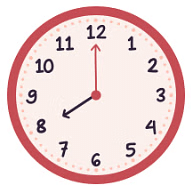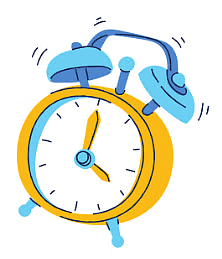Tick Tick Tick Chapter Notes | Mathematics for Class 4: NCERT PDF Download
| Table of contents |

|
| Introduction |

|
| Learning to Read Time |

|
| Numbers in a Clock |

|
| Months |

|
| Dates of a Calendar |

|
| Writing a Date |

|
| Growing Up |

|
| Being Late |

|
Introduction
Alright, class! Today we're going to talk about time. What is time, you ask? Well, time helps us know when things happen. Imagine if there was no time—we wouldn't know when to wake up, when to eat, or when to go to school! So, time is like a magical clock that tells us what part of the day it is.

Now, let's break time into parts. We have hours and minutes. Hours are like big blocks of time, and minutes are like tiny pieces of time. When we look at a clock or a watch, we see numbers in a circle. Each number tells us which hour it is.
Learning to Read Time

Teacher: Good morning, class!
Students: Good morning, teacher!
Teacher: Today, we're going to learn an exciting skill—how to read time from a watch. Who's ready to learn?
Students: (enthusiastically) We are!
Teacher: Great! Now, let's begin. First, take a look at your watch. Do you see the small hand and the big hand?
Students: Yes, teacher!
Teacher: Excellent! The small hand is called the hour hand, and the big hand is called the minute hand. Now, let's understand how they work together. Teacher: Imagine this clock is just like your watch. The hour hand tells us the hour, and the minute hand tells us the minutes.
Teacher: Imagine this clock is just like your watch. The hour hand tells us the hour, and the minute hand tells us the minutes.
Student 1: But how do we know what time it is when the minute hand is not exactly pointing to a number?
Teacher: Ah, that's a good question! When the minute hand is halfway between two numbers, we know it's half-past the hour. For example, if the minute hand is between the 6 and the 7, it's half-past six.
Student 2: What about when the minute hand is pointing straight up?
Teacher: That's called "o'clock." When the minute hand is pointing to the 12 and the hour hand is pointing to a number, it's exactly that hour. For example, if the minute hand is at 12 and the hour hand is at 6, it's 6 o'clock. Student 3: What if the minute hand is pointing to the 6?
Student 3: What if the minute hand is pointing to the 6?
Teacher: That means it's "30 minutes past" the hour. So, if the minute hand is at 6 and the hour hand is at 3, it's 3:30.
Teacher: Now, who wants to try reading the time on their watch?
Students: (excitedly) It's 10 o'clock! It's 2:30! It's half-past one!
Teacher: Well done, everyone! You've learned how to read time from a watch. Keep practicing, and soon it'll become second nature to you.
Teacher: That's all for today. See you tomorrow!
Numbers in a Clock
In a clock, 1 to 12 numbers are present.
The hands of the clock point to any of these numbers all the time.
Thin lines are present between any two numbers in a clock, representing the minutes.
If a minute hand moves from one number to the next number, it counts as 5 minutes.
If a minute hand completes 60 minutes which is equivalent to 1 hour, the hour hand moves from 1 number to the immediate next number.
Months
"Months are units of time that help us measure and organize the passage of time. Each month is a period of about 30 or 31 days, except for February, which usually has 28 days. There are twelve months in a year, and they are named January, February, March, April, May, June, July, August, September, October, November, and December. Each month has its own special characteristics, such as weather patterns, holidays, and events, which make it unique."
Dates of a Calendar
We have a total of 365 or 366 days in a year.
We have 12 months in a year. Observe a number of days in each month:
Writing a Date
Writing a date is like telling a story about when something happened. Imagine each date is like a little storybook chapter. Here’s how you can write a date:
- Start with the Day: Write the day of the month, like 1 for the first day, 2 for the second, and so on. For example, if something happened on the 5th day of the month, you write "5."
- Add the Month: Write the name of the month. For example, if it's in January, you write "January."
- Year: Finally, add the year. For example, if it happened in the year 2022, you write "2022."
So, if you're writing about something that happened on March 10, 2022, you would write it like this: "10th March 2022."
Growing Up

Growing up is an exciting journey filled with new experiences and discoveries! As we grow, our bodies change, and we learn many new things. We become stronger, taller, and more independent.
- Along the way, we make friends, learn to read and write, and discover what we enjoy doing.
- Growing up also means taking on more responsibilities and making choices for ourselves.
- It's like embarking on a great adventure, where each day brings something new to learn and explore. So let's embrace the journey of growing up with curiosity, courage, and a sense of wonder!
Being Late

Being late means arriving or doing something after the scheduled or expected time. It's like missing the starting point or deadline because you didn't manage your time properly or got delayed for some reason.
- For example, if school starts at 8:00 AM and you arrive at 8:15 AM, you're late because you didn't reach on time as planned.
- Being late can happen for various reasons, such as oversleeping, getting stuck in traffic, or not leaving enough time to get ready.
- It's essential to be mindful of the time and try to arrive at places or complete tasks before or on schedule to avoid being late.
|
26 videos|195 docs|34 tests
|















